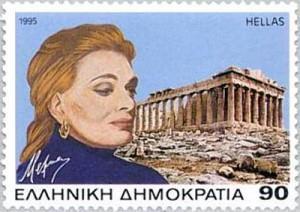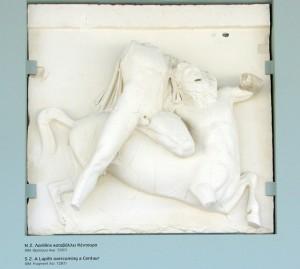The Parthenon Marbles Removal by Elgin
"The request for the restitution of the Parthenon Marbles is not made by the Greek government in the name of the Greek nation or of Greek history. It is made in the name of the cultural heritage of the world and with the voice of the mutilated monument itself, that cries out for its marbles to be returned." Evangelos Venizelos, Greek Minister of Culture at the time he made the previous statement
 Melina Mercouri, in her tireless campaign for the return of the Parthenon marbles to their home in Athens, addressed the British Authorities; "You must understand what the Parthenon Marbles mean to us. They are our pride. They are our sacrifices. They are a tribute to the democratic philosophy. They are our aspirations and our name. They are the essence of Greekness." Melina Mercouri, in her tireless campaign for the return of the Parthenon marbles to their home in Athens, addressed the British Authorities; "You must understand what the Parthenon Marbles mean to us. They are our pride. They are our sacrifices. They are a tribute to the democratic philosophy. They are our aspirations and our name. They are the essence of Greekness."
These are the Greek treasures that were violently torn from the temple's frieze by employees of Lord Elgin during the year 1802, when Greece was under Turkish occupation. The history of how these marbles finally were placed in the British Museum is long and painful. Suffice it to say here briefly how they got there.
Lord Elgin was the first ever British ambassador to the Ottoman Empire. He was more than welcomed. Turkey had declared war on Napoleon's France, and Great Britain was therefore a useful ally. His influence at the sublime Porte was beyond question. He also endeared himself to Turkish authorities in Athens by often making them costly gifts.
At that time, Lord Elgin was planning the decoration of his stately home in Scotland. He was advised that there were nothing more beautiful than the sculptures of the Greek Parthenon. He engaged a crew to make copies and moldings of these sculptures to make his house beautiful. But, once in Constantinople, his appetite became voracious. Why only copies and moldings? Why not the original sculptures? How to obtain them?
S2. A Lapith overcoming a Centaur. Copy completed with
the genuine fragment remaining in Greek hands |
 |
Copy of the stone kept in the British Museum as exhibited
at the New Acropolis Museum. Fragment nr: Akr 7287 |
There was no concern for what the Greek People under Turkish domination felt about the plundering of its most precious creations. Elgin had influence enough "and promises of solid proofs of friendship" to obtain from the Turkish vizier, limited and conditioned as it was, a permit, called a "firman." This is what it said; "That the artists meet no opposition in walking, viewing, contemplating the pictures and buildings they may wish to copy; or in modeling with chalk of gypsum the said ornaments and visible figures; or in excavating when they find it necessary in search of inscriptions among the rubbish; or when they wish to take away some pieces of stone with old inscriptions or figures there on, that no opposition be made to them, particularly as there is no harm in the said buildings being thus viewed, contemplated and drawn".
The imperative question is, can this document, by any measure of veracity, be interpreted as permission to use giant saws to tear from the temple (and causing terrible damage to the edifice) half of the sculptures from the temple frieze? Greeks say no! Archaeologists and historians, British among them, say no! By an overwhelming vote, UNESCO says no! Two hundred sixty-nine members of the European Parliament sent a petition saying no! The British Labor party says no and, astonishingly, Lord Elgin said no!
This is from Elgin letters; "It was no part of my original plan to bring away anything but models" and this from another Elgin letter; "The Turkish government denied that the persons who had sold these marbles to me had any right to dispose of them." Today more and more of the English people galvanized by the British Committee for the Restitution of the Parthenon Marbles are urging their return. The British Labor Party is on record, now newly confirmed, that should they be voted to power they will promote the return. There is reason for great optimism. The Melina Mercouri Foundation is effectively seeking support for the realization of the New Acropolis Museum in which space will be reserved for the great day when the Parthenon marbles come back home.
Melina said; "I hope that I will see the Marbles back in Athens before I die; but if they come back later, I shall be reborn."
Jules Dassin
PS (by Windmills Travel Greek Culture Department). A lot has been said about the hypothetical low level of the civilization of the Greek people under Ottoman rule. Elgin himself said that the Greek people of the time had nothing against his having plundered the monuments. Nothing could be more inaccurate!
During the Turkish occupation the Caryatids were called "The Girls of the Castle" or "The Petrified Princesses." When Lord Elgin took away one of the Caryatids, tradition says that the five who remained used to lament the loss of their sister every night. Lots of "illiterate" and "indifferent" Greeks seriously insisted they had heard the five sisters mourning! And because no marble statues have ever mourned, at least not loud enough to be heard, this mournful attitude can only be understood existing in the mourning soul of the "indifferent" Athenians!
Lord Byron strongly protested the Parthenon Marbles plundering: The following verses come from his work "Childe Harold's Pilgrimage"
Dull is the eye that will not weep to seeThy walls defaced, thy mouldering shrines removedBy British hands, which it had best behovedTo guard those relics ne’er to be restored.Curst be the hour when from their isle they roved,And once again thy hapless bosom gored,And snatch'd thy shrinking gods to northern climes abhorred!
But he was not alone to accuse Elgin for this vandalism. Sir John Newport announced:
The Honourable Lord has taken advantage of the most unjustifiable means and has committed the most flagrant pillages. It was, it seems, fatal that a representative of our country loot those objects that the Turks and other barbarians had considered sacred.
A contemporary MP Thomas Hughes, an eye witness, later wrote:
The abduction of small parts of the Parthenon, of a value relatively small but which previously contributed to the solidity of the building, left that glorious edifice exposed to premature ruin and degradation. The abduction dislodged from their original positions, wherefrom they precisely drew their interest and beauty, many pieces which are altogether unnecessary to the country that now owns them.
Last but not least, one more note by some French visitor: "It is a sad thing to remark that the civilized peoples of Europe have caused more harm to the monuments of Athens in the space of 150 years than all the barbarians together over a period of several centuries. It is hard to think that Alaric and Mahomet II respected the Parthenon, yet it has been overturned by Morosini and Lord Elgin."
(Windmills Travel Greek Culture Department) |



